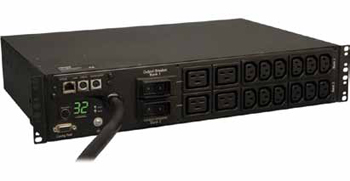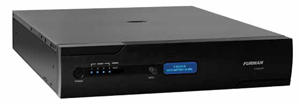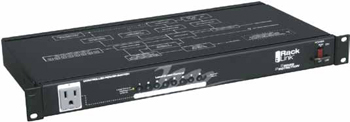Networked Power Management Goes Online

Although still in its relative infancy, IP-enabled power management technology has enjoyed significant uptake in recent years, especially in the enterprise and commercial markets. For integrators the technology is perhaps a double-edged sword, offering business opportunities, certainly, but also shaking up the traditional service contract model.
Tripp Lite single-phase monitored power distribution units offer real-time remote monitoring of voltage, frequency, and load levels via built-in network connection.At its core, said John Benz, director of marketing at Panamax/ Furman, which introduced its BlueBOLT-enabled IP power products two years ago, the technology offers a very simple service solution— remote control of a full system or component reboot. “We have estimates from a lot of our integrators that 60 or 70 percent of their service calls can be eliminated by being able to reboot components,” he said.
“You can give access to the end user so they are able to self-maintain the system without a service call. There’s an auto-reboot on our system, so if you lose an internet connection you can reboot anything you identify as a network component. That makes it self-healing.”
That back door into the system, allowing the integrator to fix a customer’s problem from an iPhone, has changed the after-sales service business model. “I’m not rolling a truck and I’m becoming more green,” said Dennis Mariasis, AV brand manager for Tripp-Lite, a company that, he reported, offers “the largest array available” of IP power products.
“As a dealer or installer, I’m starting to sell more service packages, and that’s part of my service package. And if they don’t start to embrace some of these tools they’re going to lose out if they continue to stay in the analog world,” he warned.
“Why do you need the service guy to pull out his iPhone and push the button when the client can do it himself?” argued Peter Cook, vice president at Juice Goose, which recently launched the rack-mounting iP 1520, offering three individually addressable duplex power outlets. “All customers want to save money. If the integrator can make it so the customer doesn’t need them, I think that’s going to be the competitive advantage. That’s bad news for the integrators; they’re going to have to go and find something else to do.”

The Furman F1500-UPS uninterruptible
power supply offers battery back-up,
road-proven SMP non-sacrificial zero
ground contamination surge suppression
technology, and EVS Extreme Voltage Shutdown.“Historically there’s been an expectation that for an expensive installed system the service should be provided largely within the cost of that system, certainly for a period of time,” said Murray Williams, Middle Atlantic’s product manager for electrical and electronic products. “The ability now for a contractor to provide additional value and service that reduces their overall overheads lets them be a lot more competitive in terms of what they can offer the customer. It’s not inconceivable, for example, to offer an extended service warranty for the system if they pony up a little bit of extra money up front for the networked power management as part of the installation.”
A daily selection of the top stories for AV integrators, resellers and consultants. Sign up below.
It’s easier to sell a customer IP power management if they already understand the value of an integrated network, continued Williams, who noted that Middle Atlantic offers a suite of products, RackLink, which provides IP and RS-232 integration. “If they don’t understand the need, it’s quite easy for an integrator to promote the best practice of networked power management—proactive site maintenance, optimized site performance, preemptive fault resolution, reduced system downtime, lowering the overall cost of ownership for a facility.”
Integrators contracted to keep a remote eye on a customer’s equipment are likely to enjoy a long-term relationship, he added. “The more integrated they are with the customer the more likely they are to remain a customer, and the more difficult it is to be displaced as a provider.”
Customers must consider a host of other factors when deciding which IP power products are suitable for a given facility, said Shannon Townley, senior vice president at SurgeX, whose Axess products range from entry level applications all the way up to—with the addition of Cervella network management — complex enterprise solutions. The overriding factor, of course: “What is my value versus the cost that I’m being asked to pay?”

Middle Atlantic’s RackLink, a web-enabled power management system that monitors power and temperature conditions from an open architecture that integrates seamlessly with leading control systems, and is compatible with ‘cloud’ based services.Drilling down into product features, Townley continued, “What is the ease of the interface? How will it integrate into system control, such as AMX or Crestron? Are you getting information at the box level, and is it algorithmic information where you have to use some form of a mathematical equation, versus getting data right out of the wall? What can you do outside of the power? Can you take the data and do anything with it?”
“This is the other piece of remote power control,” commented Benz. “With these platforms you’re able to monitor energy, track usage, get alerts if energy is being used when it shouldn’t, or going over a certain budget. Also, being able to schedule outlets to turn off and on at certain times will eliminate standby power, which is just a waste.”
Energy efficiency has become a critical issue. “Especially with the enterprise-level companies, they have entire staff dedicated to sustainability,” Townley pointed out. “Their sole initiative is to figure out how to save more energy. That’s right in our wheelhouse. We can go to the integrators working with these large companies and help them see the value in what they’re bringing, and be willing to pay for it. As an integrator, you’ve got the opportunity with these products to go in and sell your value and make real post-integration dollars.”

The Juice Goose iP 1520 can be accessed via internet or intranet communications using ethernet or RS-232 connection, allowing individual AC receptacles to be turned on and off and monitored for electrical current flow.Other businesses will follow the example of the larger companies, said Townley. “The trickle down effect is that after enterpriselevel and Fortune 500 companies start to institute certain initiatives it trickles down to the mid-size companies and, ultimately, the mom-and-pops.”
While manufacturers generally report that the commercial AV and, especially, enterprise markets were the first to adopt their IP power products, the technology is also gaining traction in the residential market. Many of the telephone and cable providers now offer home automation packages that, in addition to a major security component, typically include power and energy management capabilities.
The Panamax/Furman BlueBOLT platform, initially aimed at the residential market, is a cloud-based system that allows everything to be tracked, said Benz. “We graph it, we track the energy usage by amps and wattage, we set up alerts and budgets. You can put in your utility rate, for example, so the client can look at how much the system is costing them to run. Then they can set up custom budgets, and if they’re getting close to that it can send them an email. So it’s really powerful.”
But if that’s overkill for some customers, Juice Goose offers a system with basic functionality out of the box. For those with the necessary skills, Cook said, “We provide open source code, if you want to soup it up.”
While bells and whistles may be attractive, Townley cautioned, there is one feature that should always be included—a robust form of power protection: “If you have a surge or power line anomalies, it doesn’t matter if you’re getting the information if you’re constantly having equipment blow up because you’re not providing great protection.”
Steve Harvey (psnpost@nbmedia.com) has been west coast editor for Pro Sound News since 2000 and also contributes to TV Technology and Pro Audio Review. He has 30 years of hands-on experience with a wide range of audio production technologies.
